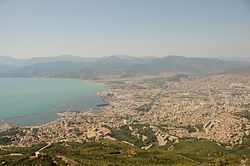| Béjaïa | |||
|---|---|---|---|
| — Commune and town — | |||
| |||
| Nickname(s): Bgayet, Bougie | |||
| Coordinates: 36°45′N 5°04′ECoordinates: 36°45′N 5°04′E | |||
| Country | |||
| Province | Béjaïa Province | ||
| Government | |||
| • Mayor | Hannache Tahar (2008-2012) | ||
| Area | |||
| • Total | 3,268.26 km2 (1,261.88 sq mi) | ||
| Population (2004) | |||
| • Total | 187,076 | ||
| • Density | 57/km2 (150/sq mi) | ||
| Time zone | CET (UTC+1) | ||
Béjaïa, Bgayet (Tifinagh:  ) is a Mediterranean port city on the Gulf of Béjaïa in Algeria; it is the capital ofBéjaïa Province, Kabylia. Under French rule, it was formerly known under various European names, such asBudschaja in German, Bugia in Italian, and Bougie [buˈʒi] (both of which are words for 'candle'). Béjaïa is the largest city in Kabylia (second largest is Tizi Ouzou), and one of the largest principally Berber speaking cities.
) is a Mediterranean port city on the Gulf of Béjaïa in Algeria; it is the capital ofBéjaïa Province, Kabylia. Under French rule, it was formerly known under various European names, such asBudschaja in German, Bugia in Italian, and Bougie [buˈʒi] (both of which are words for 'candle'). Béjaïa is the largest city in Kabylia (second largest is Tizi Ouzou), and one of the largest principally Berber speaking cities.
Geography
The town is overlooked by the mountain Yemma Gouraya, whose profile is said to resemble a sleeping woman; other nearby scenic spots include the Aiguades beach and the Pic des Singes (Monkey Peak); the latter site is a habitat for the endangeredBarbary Macaque, Macaca sylvanus, which prehistorically had a much broader distribution than at present. All three of these geographic features are contained in the Gouraya National Park. The Soummam river runs past the town
History
Béjaïa was first inhabited by Numidian Berbers. A minor port in Carthaginianand Roman times, Béjaïa was the Roman Saldae, a veteran colony founded by emperor Vespasian of great importance in the province of Mauretania Caesariensis, later in the fraction Sitifensis.
In the second or third century AD, Gaius Cornelius Peregrinus, a decurion (town councillor) from Saldae was a tribunus(military commander) of the auxiliary garrison at Alauna Carvetiorum in northern Britain. An altar dedicated to him was discovered shortly before 1587 in the north-west corner of the fort, where it had probably been re-used in a late-Roman building
It became the capital of the short-lived African kingdom of the Germanic Vandals(founded in 429-430), which was wiped out circa 533 by the Byzantines who established the African prefecture and later the Exarchate of Carthage. It had disappeared but was refounded by the Berber Hammadid dynasty (whose capital it became) in the 11th century, and became an important port and cultural center. As a principal town of the Hammadid leader, Emir En Nasser, Béjaïa flourished and was renamed En Nassria. En Nasser's son, el Mansour, built an impressive palace inside the fortifications constructed by his father. The Hammadid Empire fell in 1152, when theAlmohad ruler, Abd al-Mu'min, invaded central Maghreb from Morocco.[1] The son of a Pisan merchant (and probably consul), posthumously known as Fibonacci, there learned under the Almohad dynasty about Arabic numerals, and introduced them and modern mathematics into feudal Europe.
In the 13th century Béjaïa was acquired by theHafsid Empire when the dynasty took control ofTunis. Pirates were active along the Barbary Coast starting in the 16th century.[1]
After a Spanish occupation (1510–55), the city was taken by the Ottoman Turks in the Capture of Bougie in 1555. Until it was captured by theFrench in 1833, Béjaïa was a stronghold of the Barbary pirates (see Barbary States).
It was Christianized in the 5th century, became officially Arian under the Vandals, and then Muslim under the Berbers. City landmarks include a 16th-century mosque and a casbah (fortress) built by the Spanish in 1545.
A picture of Orientalist painter Maurice Boitel, who painted in the city for a while, can be found in the museum of Béjaïa.
.






No comments:
Post a Comment